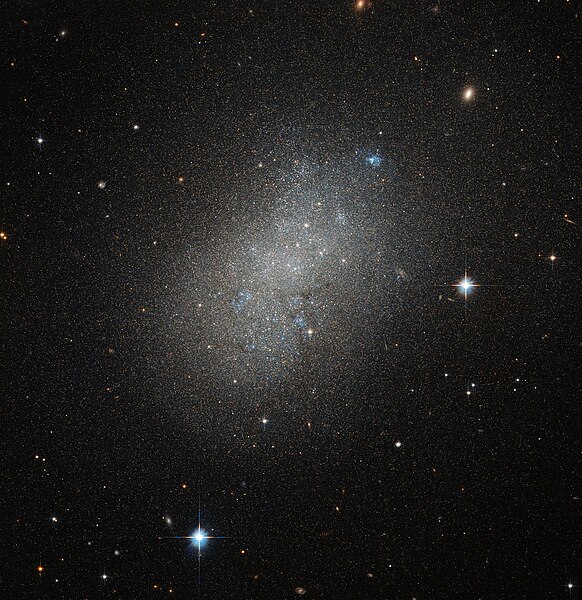The Small Magellanic Cloud (SMC) is a dwarf galaxy near the Milky Way. Classified as a dwarf irregular galaxy, the SMC has a D25 isophotal diameter of about 5.78 kiloparsecs (18,900 light-years), and contains several hundred million stars. It has a total mass of approximately 7 billion solar masses. At a distance of about 200,000 light-years, the SMC is among the nearest intergalactic neighbors of the Milky Way and is one of the most distant objects visible to the naked eye.
The Small Magellanic Cloud (Source: Digitized Sky Survey 2)
Panoramic Large and Small Magellanic Clouds as seen from ESO's VLT observation site. The galaxies are on the left side of the image.
VISTA's view of the Small Magellanic Cloud. 47 Tucanae (NGC 104) is visible to the right of the Small Magellanic Cloud.
The Small Magellanic Cloud pictured by the Hubble Space Telescope
A dwarf galaxy is a small galaxy composed of about 1000 up to several billion stars, as compared to the Milky Way's 200–400 billion stars. The Large Magellanic Cloud, which closely orbits the Milky Way and contains over 30 billion stars, is sometimes classified as a dwarf galaxy; others consider it a full-fledged galaxy. Dwarf galaxies' formation and activity are thought to be heavily influenced by interactions with larger galaxies. Astronomers identify numerous types of dwarf galaxies, based on their shape and composition.
The Large Magellanic Cloud, a satellite galaxy of the Milky Way
Dwarf galaxies like NGC 5264 typically possess around a billion stars.
The Phoenix Dwarf Galaxy is a dwarf irregular galaxy, featuring younger stars in its inner regions and older ones at its outskirts.
UGC 11411 is a galaxy known as an irregular blue compact dwarf (BCD) galaxy.








